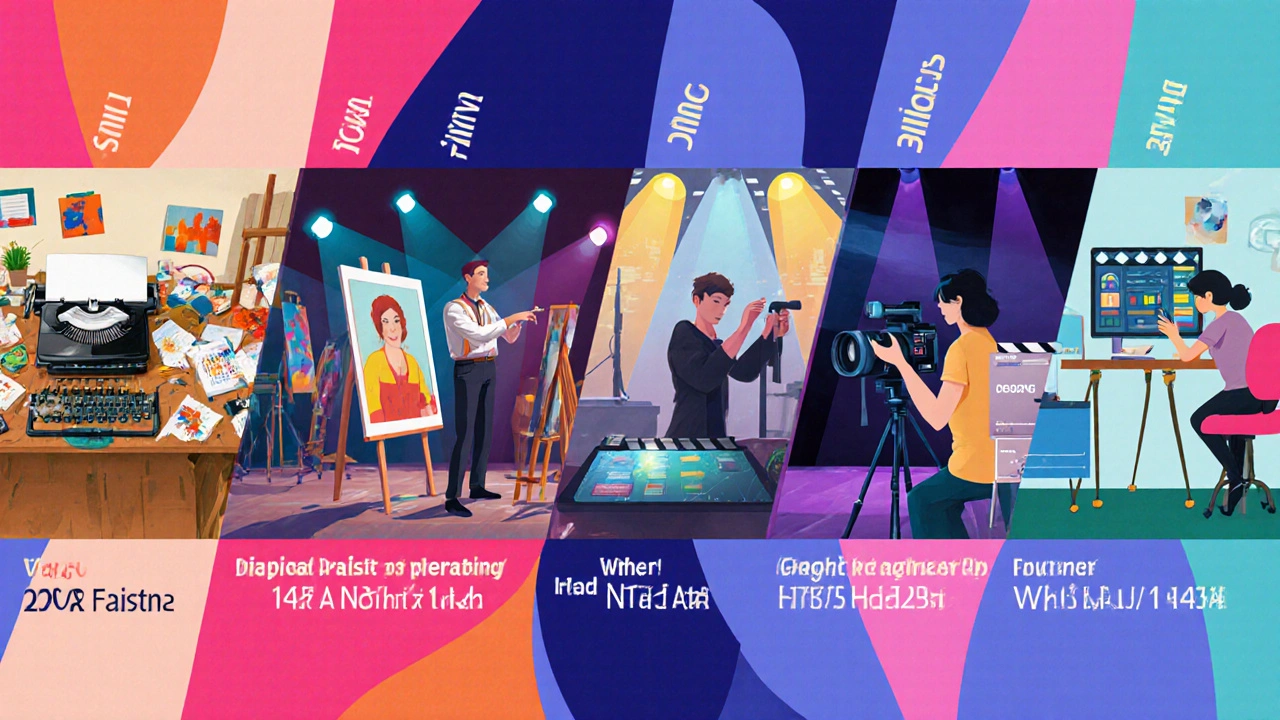MFA Program Duration Estimator
Calculate Your MFA Timeline
Enter your details above to see your estimated completion timeline.
Ever wondered why some MFA graduates walk off the stage after two years while others are still polishing their portfolios five years later? The answer isn’t a one‑size‑fits‑all number-it hinges on discipline, study mode, residency rules, and even the type of capstone you choose. This guide breaks down every factor that shapes the MFA duration so you can map a realistic timeline for your own Master of Fine Arts journey.
What Exactly Is an MFA?
Master of Fine Arts (MFA) is a terminal graduate degree focused on professional practice in visual, literary, performing, or media arts. Unlike research‑oriented MA programs, an MFA centers on creating a body of work that demonstrates mastery of a chosen artistic discipline. Graduates earn the right to call themselves professionals, not just scholars.
Typical Time Frames by Discipline
Different art forms have distinct curricular structures, which translates directly into how long students spend in school. Below is a quick snapshot of the most common MFA tracks.
| Discipline | Standard Credits | Typical Full‑Time Duration | Typical Part‑Time Duration |
|---|---|---|---|
| Creative Writing | 60 | 2 years | 3-4 years |
| Visual Arts (Studio) | 66‑72 | 2‑3 years | 4‑6 years |
| Theatre (Performance) | 60‑66 | 2‑3 years | 3‑5 years |
| Film Production | 72‑78 | 3 years | 5‑7 years |
| Design (Graphic, Interaction) | 66 | 2‑3 years | 4‑5 years |
These numbers are averages from U.S. and Canadian institutions in 2024‑2025. Schools in Europe or Oceania may follow a semester model that shifts the timeline by a few months.
Key Factors That Stretch or Shrink Your Timeline
- Credits required - Most programs set a minimum credit load (often 60‑78). Taking a heavier course load can shorten the calendar, but it may limit studio time.
- Residency requirements - Some MFA tracks, especially studio‑based ones, demand a minimum number of on‑campus weeks each semester. Online students who must travel for residencies will add travel weeks to their schedule.
- Thesis vs. capstone - A traditional thesis (e.g., a manuscript or research paper) can be completed faster than a multi‑medium capstone that involves exhibitions, performances, or film festivals.
- Part‑time enrollment - Working artists often spread the same credit load over three to six years, which is the most common way to keep income flowing while studying.
- Accreditation and program structure - Schools accredited by the National Association of Schools of Art and Design (NASAD) tend to have stricter credit and residency guidelines, influencing total time.
Full‑Time vs. Part‑Time: How to Choose
If you can afford to quit your day job, full‑time enrollment slashes the clock. Most full‑time MFA students take 12-15 credit hours per semester, finishing the required 60‑78 credits in about two years. Part‑time learners usually register for 6-9 credits, stretching the program to three or more years.
Consider these questions before deciding:
- Do you need a steady income? If yes, part‑time might be the only viable route.
- How much studio or rehearsal time does your discipline demand? Visual artists often need uninterrupted blocks for gallery installations.
- Are you targeting a specific graduation date for a fellowship or exhibition? Full‑time can help you meet tight deadlines.
Online MFA Programs: A New Speed Bump?
Online options exploded after 2020, offering flexibility but sometimes adding hidden time costs. While you can submit assignments from anywhere, most reputable online MFAs still require at least one 2‑week residency per year for critiques and networking. That requirement adds travel time that can extend the overall schedule, especially for students in remote regions like New Zealand.
However, digital‑focused tracks-such as Interactive Design MFA-often let you complete a 66‑credit program in 18‑24 months because the coursework is entirely virtual and the capstone is an online portfolio.

Accelerating Your MFA: Tips from Recent Grads
- Front‑load core courses. Register for the highest‑credit classes in your first semester to build momentum.
- Plan your thesis early. Draft a proposal before you start classes; many schools approve topics within weeks, letting you begin research immediately.
- Leverage summer sessions. Some institutions offer intensive summer studios that count toward credit totals, shaving up to six months off the calendar.
- Network for collaboration. Partnering with peers on joint exhibitions or film projects can fulfill multiple requirements at once.
- Use credit transfers. If you have relevant graduate‑level coursework from another university, negotiate transfer credits to reduce total load.
Budgeting Your Time: Sample 2‑Year Timeline (Full‑Time)
- Fall Semester (Month 1‑4)
- Enroll in 12 credits: foundational studio, art theory, and research methods.
- Submit a brief thesis proposal (1‑2 pages).
- Winter Break (Month 5‑6)
- Develop a project plan for your capstone.
- Attend a residency workshop (if required).
- Spring Semester (Month 7‑10)
- Take 12 credits, focusing on advanced studio work and a critique course.
- Begin creating the core pieces for your final exhibition.
- Summer Session (Month 11‑12)
- Enroll in a 6‑credit intensive studio to finish remaining requirements.
- Finalize your thesis/capstone outline.
- Year 2 - Fall & Spring
- Complete remaining 30‑36 credits, integrating thesis research and exhibition preparation.
- Present your final project at the department’s graduation showcase.
Adjust the numbers up or down based on your discipline’s credit requirements and any part‑time or online constraints.
Common Misconceptions About MFA Timing
- "All MFAs are two years." - Only full‑time, on‑campus programs in certain fields fit that window.
- "Online MFAs are faster." - Flexibility doesn’t always translate to fewer credits; residency and capstone standards often keep the timeline similar.
- "You can skip the thesis." - Most accredited programs mandate a substantial final project, whether it’s a manuscript, exhibition, or film.
Next Steps: Planning Your Own Timeline
Now that you’ve seen the variables, it’s time to build a personal roadmap.
- Identify your discipline and preferred study mode (full‑time, part‑time, online).
- Collect credit requirements from at least three programs you’re interested in.
- Map out a semester‑by‑semester credit load that aligns with your income and life commitments.
- Schedule any required residencies early to avoid last‑minute travel conflicts.
- Set a provisional graduation date and work backward to lock in thesis milestones.
Stick to the plan, but stay flexible-artistic breakthroughs often happen when you least expect them.

How many credits does a typical MFA require?
Most full‑time MFA programs ask for 60-78 graduate‑level credits. Visual arts and film tracks trend toward the higher end because of studio and production courses.
Can I finish an MFA in less than two years?
It’s rare but possible if you enroll in a summer intensive, transfer credits, and take a heavy 18‑credit semester load. Most schools still require a minimum residency period that pushes the timeline to about 24 months.
Do online MFAs have the same time requirements as on‑campus programs?
Accredited online MFAs usually mirror the credit count of their on‑campus counterparts. The main difference is flexibility in when you complete those credits, not a shorter overall duration.
What is the fastest way to complete an MFA while working full‑time?
Enroll part‑time but take advantage of summer sessions and apply any transferable graduate credits you already hold. Prioritize courses that count toward both your major and elective requirements.
Do all MFAs require a thesis?
Most do, but the format varies. Creative writing often ends with a manuscript, while studio arts finish with an exhibition, and film programs culminate in a short feature or documentary.


Comments
John Fox
MFA programs can range from two to six years depending on the field.
Tasha Hernandez
Oh, look at the endless academic maze-because who doesn’t love juggling thesis deadlines with existential dread? Your guide is a masterpiece of melodrama, dripping with all the glitter of bureaucratic red tape.
Christina Morgan
It’s truly refreshing to see such a thorough breakdown of MFA timelines; the variety across disciplines really underscores how personalized graduate art education is. Many prospective students underestimate the impact of residency requirements, assuming online work eliminates all travel, only to discover mandatory on‑campus weeks. When you consider credit load, a heavier semester can accelerate graduation, but it may also compress studio time, which is essential for artistic development. Part‑time routes, while financially sensible, inevitably stretch the journey, often aligning better with professional obligations. The guide’s emphasis on early thesis planning is spot‑on-having a proposal approved early can shave months off the process. Summer intensive sessions are another hidden gem; they not only count toward credit totals but also provide immersive experiences that foster rapid skill growth. Credit transfers, as mentioned, are a strategic move, especially for those coming from related graduate work or interdisciplinary studies. It’s also worth noting that accreditation bodies like NASAD enforce stricter residency and credit standards, which can add layers of complexity. Online MFAs, despite their flexibility, still mirror the credit demands of their on‑campus counterparts, so students shouldn’t expect a shortcut in duration. The advice to map a semester‑by‑semester credit load is practical, helping students balance workload with income needs. Scheduling residencies early can prevent last‑minute travel hassles that often derail timelines. Setting a provisional graduation date and working backward, as suggested, offers a realistic checkpoint system. Moreover, artistic breakthroughs often happen spontaneously, so while a roadmap is crucial, flexibility remains key. Lastly, remember that each discipline’s capstone-whether a manuscript, exhibition, or film-has its own production timeline, influencing the overall length. In sum, this guide equips future MFAs with the tools to tailor their path, balancing ambition with practicality.
Kathy Yip
One has to wonder about the philosophical underpinnings of time in creative pursuits-does a longer residency inherently produce deeper work? The balance between structured study and organic inspiration is a delicate one. Even if I misspæl a word here, the idea stands clear.
Bridget Kutsche
Great overview! If you’re budgeting your schedule, try pairing a high‑credit core class with a lighter elective each semester to keep stress manageable. Also, look for schools that offer credit for professional exhibitions-they can really speed things up. Keep your eye on scholarship deadlines early, they often have strict application windows.
Jack Gifford
Just a heads‑up: when you’re drafting your thesis proposal, make sure to follow the department’s formatting guide to the letter. A clean, well‑structured proposal can save you weeks of back‑and‑forth with advisors. And don’t forget to proofread-grammar matters even in creative fields.
Sarah Meadows
Patriotic scholars know that American MFA programs set the gold standard, and any deviation is just a cost‑inefficient detour. Leverage the domestic network-state funding, veteran benefits, and national art grants are unparalleled. Remember, the jargon of accreditation is a tool to maintain our cultural supremacy.